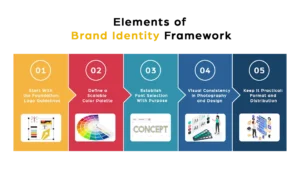
When a brand looks cohesive, it builds trust. And behind that trust lies a carefully crafted visual brand identity—the logo you recognize instantly, the colors you associate with a feeling, and the fonts that speak the brand’s personality. A skilled digital marketing company knows that creating these elements isn’t enough. What truly brings longevity and clarity is a visual identity framework—a guide that doesn’t just tell, but scales. Here’s how to build brand guidelines that keep your brand consistent, flexible, and future-ready.
Ready to make your brand unforgettable? Start with 42Works.
Why Visual Brand Identity Matters
But before we get to the how, let’s talk about the why.
Visual brand identity is more than design; it’s a strategic tool. It’s how you communicate your values, tone, and story in one glance. Your identity should speak for itself everywhere, from your packaging design to your social media posts.
But without written standards, visual chaos can occur: stretched logos, off-brand colors, or mismatched fonts. These missteps chip away at recognition and professionalism. That’s where brand guidelines become essential.
Key Elements of a Scalable Brand Identity Framework

Creating a brand identity that scales starts with the right building blocks. It’s not just about design; it’s about clarity, consistency, and structure. Here are the key elements every strong brand framework should include:
1. Start With the Foundation: Logo Guidelines
Your logo is your brand’s most visible asset. It’s also the easiest to misuse if rules aren’t in place. So it is important to know which logo type fits your brand.
A strong brand style guide should answer:
- What are the approved logo versions (horizontal, stacked, icon-only)?
- How much clear space must surround the logo?
- What are the minimum size specifications for digital and print?
- Are there restrictions on backgrounds or color overlays?
Use visual examples to show acceptable and incorrect applications. And if you’re working with a company that provides logo services, request vector logo files and adaptable lockups early on.
2. Define a Scalable Color Palette
Color is emotional—it influences how people feel about your brand within seconds. And colors do affect your brand. That’s why color palette branding needs planning.
Create a system with:
- Primary colors: These dominate your branding (typically 1–3 colors).
- Secondary colors: These play a backup role; they exist to support your design without taking the spotlight.
- Accent colors: For call to action or any type of highlight.
- Technical spec: HEX, RGB, CMYK & Pantone values help your brand stay consistent on the web or in print.
Example: McDonald’s uses golden yellow (Pantone 1235 C) and red (Pantone 485 C) to match hunger and happiness, which relates to their brand identity.
3. Establish Font Selection With Purpose
Typography is about so much more than aesthetics; it’s voice. Fonts have personality, whether it’s of the bold and commanding or soft and friendly variety. Effective font selection includes:
- A primary typeface for headings and a secondary one for body text.
- Clearly defined hierarchy styles (sizes of text such as H1 through H6, line height, and spacing).
- Web-safe and print-compatible font options.
- Licensing information and download links.
Avoid using too many fonts—two to three is ideal. A digital marketing company can provide you with custom typefaces if needed or select Google fonts for scalability.
4. Visual Consistency in Photography and Design
Beyond logos and colors, your brand is also defined by the visuals you use—photos, illustrations, and layouts.
Your brand style guide should define:
- Preferred photography tone: Choose a consistent look, like natural lighting, candid moments, or warm tones, to create a unified visual feel.
- Dos and don’ts for filters or overlays: Do indicate what types of edits are allowed (e.g., no heavy filtering on photos, only light color corrections) to ensure brand clarity is not lost through distortion.
- Illustration style: Whether it’s flat icons, a set of hand-drawn sketches, or isometric design elements, pick one that supports the personality behind your brand.
- Grid systems for layouts: Implementing balance even in your layout grid can be a great technique to maintain structure and organization across various print or digital content.
The idea is to make the viewing experience as close to that of your target audience as possible, regardless of platform.
5. Keep It Practical: Format and Distribution
The most well-crafted brand guidelines are worthless when nobody adheres to them. Here is how you can turn your guidelines into something actionable:
- Use visuals: Show real text, not just explanations in writing.
- Make it digitized: Instead of on paper and pencil, try Notion or Figma (or even PDF portals) for easy sharing.
- Version: Maintain the brand language as it evolves.
- Train teams: Teach internal designers and marketers, as well as external partners.
You can also invest in professional branding services, as they often create an interactive, cloud-based brand guide that evolves with your team.
Don’t Miss This: 42Works has been creating standout brand identities that resonate deeply with your audience.
Conclusion: Don’t Just Design—Systemize
A strong brand doesn’t happen by chance. It’s designed, refined, and protected by systems that scale. Whether you’re building from scratch or rebranding, investing in brand guidelines ensure that your visual brand identity remains consistent, recognizable, and emotionally resonant across all touchpoints.
Need a brand that scales with your vision? Let 42Works craft it right from the start.
FAQs:
- Why do brand guidelines matter so much?
They keep everything consistent, from your logo to your social posts, so your brand always looks and feels the same everywhere.
- How often should I update my brand style guide?
Anytime your brand evolves or introduces something new, it’s a good idea to refresh the guide.
- Can I create brand guidelines without hiring an agency?
You can, but working with experts helps you avoid mistakes and build a brand that actually works across platforms.
- What does a scalable brand identity mean?
It means your branding stays strong and consistent whether it’s on a billboard, an app, or a business card.
- How can 42Works help with my brand identity?
42Works helps you create a brand that’s not just good-looking but also strategic and built to grow with you.
- How do I contact 42Works?
You can email us at contact@42works.net, call +91-9988944242, or simply fill out the form on our website.
You Might Want To Check These Out:
How do colors affect your brand?
4 Ways Top Graphic Designers Build Brand Identities That Stand Out
How to Build a Brand: A Complete Step-by-Step Guide For Marketers & Entrepreneurs


